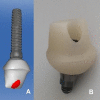Fracture resistance of different implant supported ceramic abutment/crown systems
- PMID: 31309198
- PMCID: PMC6614687
- DOI: 10.26650/eor.20199657
Fracture resistance of different implant supported ceramic abutment/crown systems
Abstract
Purpose: The purpose of this study was to investigate the fracture resistance and failure modes of different non-aged and aged abutment/crown systems.
Materials and methods: One hundred dental implants (diameter 4.3 mm and length 11.5 mm) were restored with five abutment/crown systems: G1: a lithium disilicate hybrid abutment crown, G2: a lithium disilicate crown cemented on a lithium disilicate hybrid abutment, G3: a lithium disilicate crown cemented on a zirconia hybrid abutment, G4: a direct veneer porcelain layering on a zirconia hybrid abutment, and G5: a lithium disilicate crown cemented on a prefabricated all-zirconia abutment. Each group was divided into two groups (n=10) as control (non-aged) and thermomechanically aged. The fracture resistance test was performed. Failures during the aging process and after the fracture resistance test were examined.
Results: Both of the factors (restoration type and aging) affected the fracture resistance values and there was not an interaction between the factors (p>0.05). When fracture resistance values were compared regardless of aging, the highest values were observed in G3 and G4, respectively (p<0.05). When comparing the fracture resistance values, regardless of the restoration type, the aged group showed a significant lower fracture resistance value than control group (p<0.05).
Conclusion: A titanium base enhanced the fracture resistance of zirconia abutments. Thermomechanical aging decreased the fracture resistance of the tested ceramic abutment/crown systems. The major failure mode was the abutment fracture.
Keywords: Dental implant; abutment design; ceramic; oYttria-stabilized; tetragonal zirconia polycrystals.
Figures




Similar articles
-
Laboratory Fracture Resilience of Hybrid Abutments Used in Oral Rehabilitation: A Systematic Review.J Funct Biomater. 2022 Aug 15;13(3):120. doi: 10.3390/jfb13030120. J Funct Biomater. 2022. PMID: 35997458 Free PMC article. Review.
-
Fracture resistance of crowns cemented on titanium and zirconia implant abutments: a comparison of monolithic versus manually veneered all-ceramic systems.Int J Oral Maxillofac Implants. 2012 Nov-Dec;27(6):1448-55. Int J Oral Maxillofac Implants. 2012. PMID: 23189296
-
Fracture Resistance of Titanium-Based Lithium Disilicate and Zirconia Implant Restorations.J Prosthodont. 2018 Aug;27(7):644-650. doi: 10.1111/jopr.12765. Epub 2018 Feb 8. J Prosthodont. 2018. PMID: 29417647
-
Effect of fatigue loading on the fracture strength and failure mode of lithium disilicate and zirconia implant abutments.Clin Oral Implants Res. 2018 Jan;29(1):20-27. doi: 10.1111/clr.13034. Epub 2017 Jun 30. Clin Oral Implants Res. 2018. PMID: 28664585
-
Fracture Resistance of Titanium, Zirconia, and Ceramic-Reinforced Polyetheretherketone Implant Abutments Supporting CAD/CAM Monolithic Lithium Disilicate Ceramic Crowns After Aging.Int J Oral Maxillofac Implants. 2019 May/June;34(3):622–630. doi: 10.11607/jomi.7036. Epub 2019 Feb 4. Int J Oral Maxillofac Implants. 2019. PMID: 30716141
Cited by
-
Titanium Base Abutments in Implant Prosthodontics: A Literature Review.Eur J Dent. 2022 Feb;16(1):49-55. doi: 10.1055/s-0041-1735423. Epub 2021 Nov 18. Eur J Dent. 2022. PMID: 34794201 Free PMC article.
-
Mechanical Stability of Screw-Retained Monolithic and Bi-layer Posterior Hybrid Abutment Crowns after Thermomechanical Loading: An In Vitro Study.Materials (Basel). 2021 Dec 8;14(24):7539. doi: 10.3390/ma14247539. Materials (Basel). 2021. PMID: 34947134 Free PMC article.
-
Effect of abutment types and resin cements on the esthetics of implant-supported restorations.J Adv Prosthodont. 2023 Jun;15(3):114-125. doi: 10.4047/jap.2023.15.3.114. Epub 2023 Jun 28. J Adv Prosthodont. 2023. PMID: 37441718 Free PMC article.
-
The Fracture Resistance Comparison between Titanium and Zirconia Implant Abutments with and without Ageing: Systematic Review and Meta-Analysis.Dent J (Basel). 2024 Aug 23;12(9):274. doi: 10.3390/dj12090274. Dent J (Basel). 2024. PMID: 39329840 Free PMC article. Review.
-
Laboratory Fracture Resilience of Hybrid Abutments Used in Oral Rehabilitation: A Systematic Review.J Funct Biomater. 2022 Aug 15;13(3):120. doi: 10.3390/jfb13030120. J Funct Biomater. 2022. PMID: 35997458 Free PMC article. Review.
References
-
- Adell R, Eriksson B, Lekholm U, Brånemark PI, Jemt T. Long-term follow-up study of osseointegrated implants in the treatment of totally edentulous jaws. Int J Oral Maxillofac Implants. 1990;5(4):347–59. - PubMed
-
- Truninger TC, Stawarczyk B, Leutert CR, Sailer TR, Hämmerle CH, Sailer I. Bending moments of zirconia and titanium abutments with internal and external implant-abutment connections after aging and chewing simulation. Clin Oral Implants Res. 2012. January;23(1):12–8. 10.1111/j.1600-0501.2010.02141.x - DOI - PubMed
LinkOut - more resources
Full Text Sources
